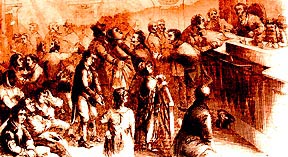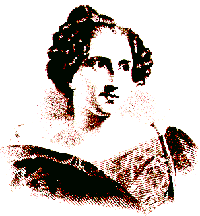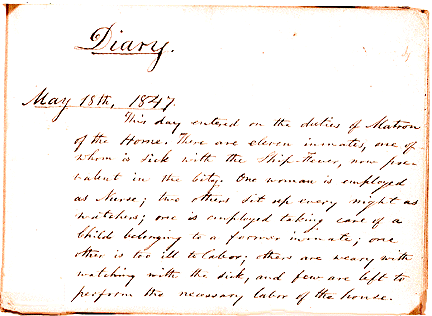December 1844: James Polk was elected President, swept in on a tide of expansionist views on annexing Texas, California and Oregon. New York City was experiencing a colossal boom, which had begun with the opening of the Erie Canal in 1825, developing the city into the premiere trading center of the Eastern Coast and its harbor into a forest of masts.
In droves, Irish immigrants were coming to American shores, in particular to New York, driven from their native land by the devastating and persistent potato famine. As Charles Dickens had noted two years earlier upon visiting New York's slums, the poor were becoming poorer, while the rich became richer. Nativism, an attitude of protecting native inhabitants against immigrants, namely the Irish, prevailed among many prominent New Yorkers. They spoke of "an oozing leak of a sewer pipe into the crystal water of a well." The worst alarmists quoted Jefferson who had said in 1787, "When we get piled upon one another in large cities, we shall become as corrupt as in Europe..."
As the city filled, so did its prisons. Conditions deteriorated as crowding grew. In December, a call was sent out by the Inspectors of Sing Sing to citizens to form a society with three main purposes: to ameliorate the condition of prisoners; to improve prison discipline; to help discharged prisoners find a means of earning a living. On December 15, 1844, in response to this call, a group of New York City business, political, and philanthropic leaders that included well-known Quaker abolitionist, Isaac Tatem Hopper, formed the Prison Association of New York. From the beginning, a Female Department of the Association was created by a number of women who met with Isaac Hopper and took upon themselves the task of visiting prisons in the area. Their conclusion: "A home needs to be provided for the homeless; other doors need to be open to them than those that lead to deeper infamy." Concerning the rights of women, Isaac Hopper exemplified the Quaker attitude that there was an inherent equality between men and women; it never occurred to him "that there was anything unseemly in a woman using any gift with which God has endowed her, or transacting any business which she had the ability to do well."
In January, 1845, the Female Department, a "regularly constituted body" of the Prison Association, was formed. Among the leaders of the Female Department of the New York Prison Association was Abigail Hopper Gibbons, daughter of Isaac T. Hopper and leading light of the WPA for the next 50 years. The first Hopper Home was established in June, 1845 on Fourth Street near Eighth Avenue (later to move to 191 Tenth Avenue). In its first three years, more than 450 women were sheltered there. The custom was to find them jobs as domestic help. Many were sent away - after a short period of training at the Home - to families far from "the corrupting sway" of the city, which in those days were "drink, bad company, and evil influences."
The volunteer ladies of the Female Department -- soon known as the Women's Prison Association -- visited prisons and reported on conditions in the jails and station houses. They also taught sewing, basic eading skills and an appreciation for a higher orality. One of these women was Catherine M.Sedgwick, a well-known novelist of the time. Mrs.Sedgwick, who said "intemperance is the pervading cause of the vagrancy and crime in our city," became the first president of the association in 1848, an office she held until 1863- It was the hope of the Board that the former prisoners coming to the Home would form new, good habits, such as abstinence from tobacco, snuff, alcohol, foul language, and profanity. In its first decade of operation, the hired matrons at the Home constantly urged that the young women who drank should be discharged from the residence, but the Board repeatedly denied these requests saying the women deserved a second chance.
In 1853, the Female Department separated from the Prison Association. Abigail Hopper Gibbons, daughter of Isaac Hopper, took the lead in acquiring a New York State Charter for the Women's Prison Association, traveling to Albany to importune the Legislature. Mrs. Gibbons married to James S. Gibbons, a financier who was also a Quaker and an abolitionist - had long been involved in her father's philanthropies, his work with slaves. It was she who had her father to create a Female Department of the Prison Association. Once WPA had a state charter, Mrs. Gibbons was able to implement many important reforms. The first of these was to mandate that there be female matrons in all state penal facilities where there women prisoners. This, however, did not occur i887 despite Mrs. Gibbons' tireless lobbying.
America's Civil War began in i861. Mrs. Gibbons and her eldest daughter went to the fro to work, with few intermissions, as nurses in hospitals and camps. Funding the operations of WPA was always a challenge, but it became more difficult during the war. The annual report for 1862 noted, "our regular supplies have been somewhat diminished the past year by the fact that the necessities of our military hospitals force the stream of charity into one channel." The Directors were always on the lookout for donations from charitable men and women in New York, and in each annual report listed all gifts, not only of money, but also of reading materials, baked and preserved goods, coal, turkeys (for holidays), and useful equipment. As is true today, the Board noted that "the cost of maintaining the inmates in the Home is far less than state prisons." Yet, "not more than a quarter of the expense of the Association can be covered by the earnings of the inmates. Many come with health greatly impaircd. A still greater number are fitted to do house work alone, and that there is no means of doing until they leave the Home. The efforts to obtain employment for them encounters so much opposition from the prejudices of the unthinking and the unfeeling ... that it is quite out of the question to make the Home self-sustaining." Virtue and perseverance were clearly rewarded in 1865 when WPA received
a $50,000 legacy from Charles Burrall of Hoboken, a sum which would yield
$3,5oo annually.
|








 ©1995, 1999 The Women's Prison Association & Home, Inc. All rights reserved. No part of the original 1995 book or of this 1999 web reproduction may be further reproduced or re-transmitted in any form or by any means, electronic or mechanical, including photocopying, recording, or any information storage and retrieval system, without permission in writing from the publisher.
©1995, 1999 The Women's Prison Association & Home, Inc. All rights reserved. No part of the original 1995 book or of this 1999 web reproduction may be further reproduced or re-transmitted in any form or by any means, electronic or mechanical, including photocopying, recording, or any information storage and retrieval system, without permission in writing from the publisher.